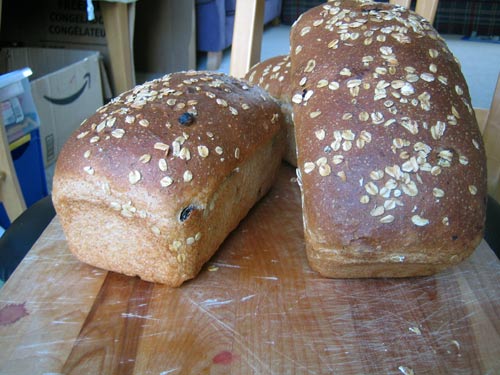
I love cinnamon raisin breads. I make them often and find them to be the perfect breakfast treat, with just enough sweetness to not require jam, just enough fruit to constitute more than just carbs for breakfast.
I've baked many different raisin bread recipes. Some I find to be too sweet, others too heavy on the whole wheat (though white flour alone I don't find that satisfying either). This recipe, from Jeffrey Hamelman's Bread, is one of the best raisin breads I have found: I particularly enjoy how the oats on top of the loaf toast up nicely.
(Despite my initial misgivings about his attitude toward amateur bakers, I do have to say that all of the recipes from Hamelman's book that I have baked have been exceptionally good. I find myself thumbing through it almost as often as The Bread Baker's Apprentice these days.)
One interesting thing Hamelman mentions in a side note is that chemical compounds in bark-based spices such as cinnamon and nutmeg inhibit yeast activity, so more yeast than typical is required. This is a good thing to keep in mind when adapting a normal bread into a cinnamon raisin bread, something I do often.
And a warning: this recipe makes three substantial loaves. It pushed the capacity of the standmixer. You may want to consider halving the quantities.
Cinnamon Raisin Oatmeal Bread
Makes 3 loaves
24 oz (5 1/2 cups) bread or all-purpose unbleached flour
8 oz (1 7/8 cups) whole wheat flour
5.3 oz (1 5/8 cups) rolled oats
20 oz (2 1/2 cups) water
3.5 oz (3/8 cups) milk
2.4 oz (3 tablespoons) honey
2.4 oz (5 1/2 tablespoons) vegetable oil
.7 oz (1 tablespoons plus 1/2 teaspoon) salt
.37 oz (1 1/4 tablespoon) instant yeast
.5 oz (2 tablespoons) ground cinnamon
10.6 oz (2 cups) soaked and drained raisins
At least half an hour before you begin, soak the raisins in warm water.
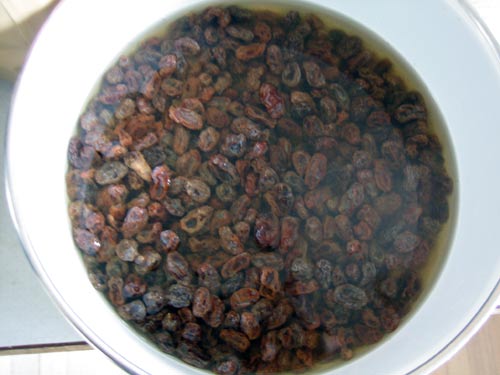
Doing so plumps them, which makes them softer and moister in the loaf and also prevents the ones on the surface of the loaf from burning. Just prior to adding the raisins to the loaf, you'll pour the water out.
Next, soak the oats in the 2 1/2 cups water for 20 to 30 minutes.
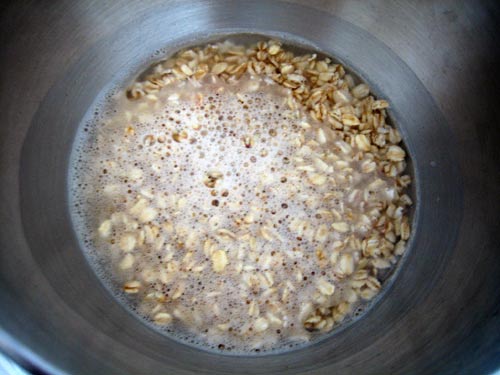
If you are using active dry yeast instead of instant yeast, which I did, withhold 1/2 cup of the water to proof the yeast in.
Mix the flours, yeast, milk, honey, oil, salt, and cinnamon into the oats. Mix well, until all of the flour is hydrated. Knead by hand for 5 minutes or in a standmixer for 3, then mix in the drained raisins. Knead or mix until the raisins are distributed throughout the dough.
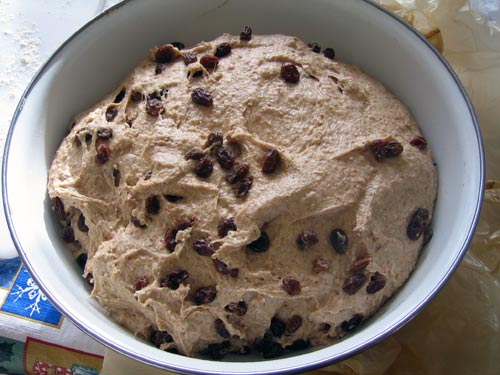
Cover the bowl of dough and allow it to rise for 1 hour. Then remove the dough from the bowl and fold it, degassing it gently as you do. The images below illustrate this technique.
Place the dough on a floured work surface, top side down.
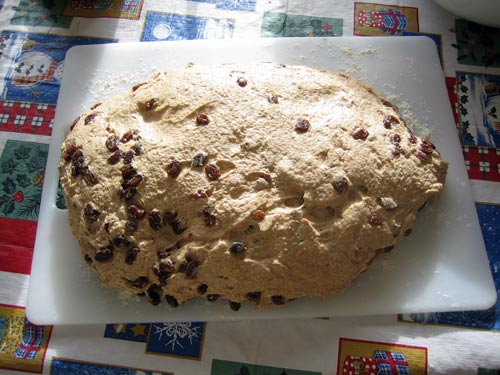
Fold the dough in thirds, like a letter, gently degassing as you do.
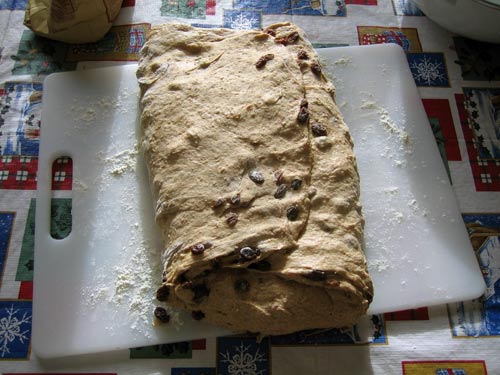
Fold in thirds again the other way.
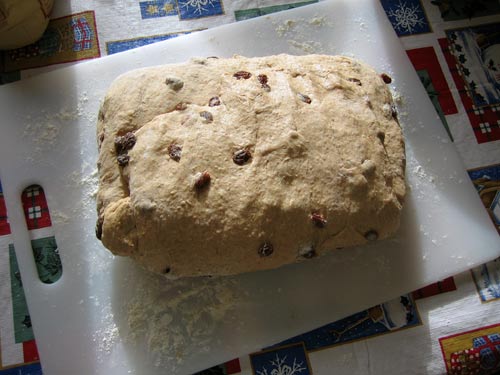
Flip the dough over, dust off as much of the raw flour as you can, and place it back into the bowl.
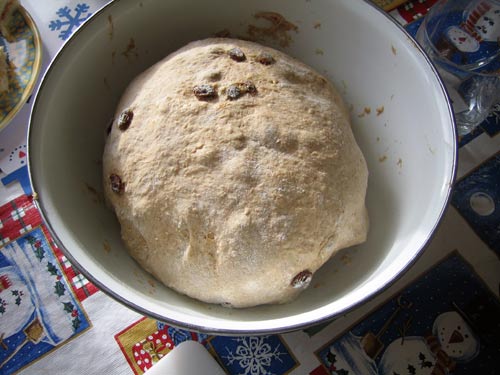
Cover the bowl and allow the dough to rise in bulk again for another hour. Then divide the dough in thirds and shape the loaves.
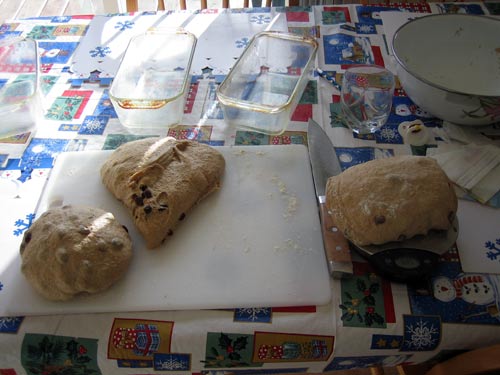
Place each shaped loaf into a greased bread pan.
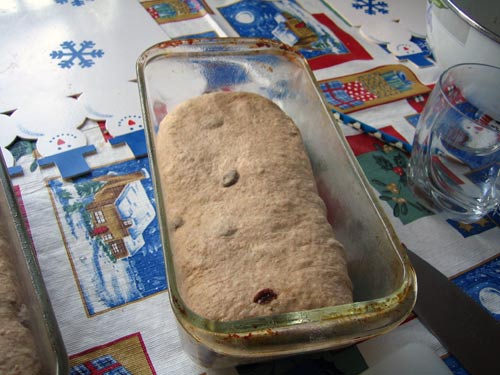
Spray or gently brush each loaf with water and sprinkle with some more oats.
Cover the pans and set aside to rise until the loaves crest above the edge of the pans, roughly 90 minutes.
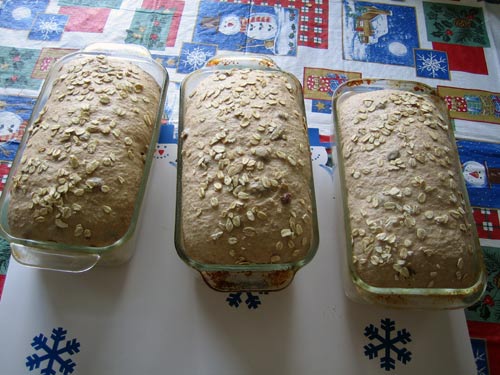
Preheat the oven to 450. Place the loaves in the center rack of the oven. After 5 minutes, reduce the oven temperature to 375. Rotate the loaves 180 degrees after 20 minutes, and bake for another 15 to 25 minutes, until the tops of the loaves are nicely browned, the bottoms of the loaves make a hollow sound when tapped, and the internal temperature of the loaf registers above 185 degrees when measured with an instant read thermometer.
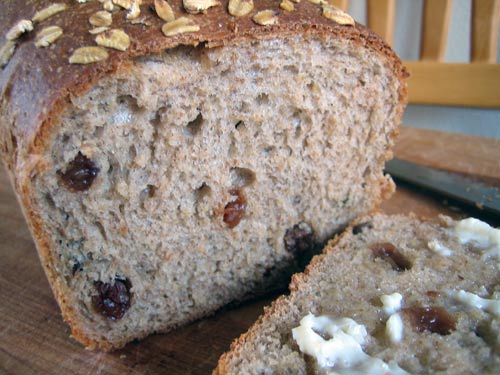
Yeah, ok, you are supposed to let the loaves cool before slicing. I couldn't though, and I have no regrets!
Related Recipes: Sweet Corn Raisin Bread, Maple Oatmeal Bread, Struan Bread.
Comments
I'm making this bread right now, and I just hit me, do you soak the raisins then measure, I'm measuring by weight, or measure then soak? I know it doesn't matter that much being that they're just raisins, and I measured then soaked figuring I would be adding more raisins which I would prefer. But I was just wondering if there is a standard method here. The more I think about it if the recipe calls for x amount of soaked/drained raisins the you should soak them first then measure.
demegrad
http://www.demegrad.blogspot.com
Old question but: the recipe calls for "10.6 oz (2 cups) soaked and drained raisins"
Generally, that means that it's 10.6oz/2cups raisins measured after soaking and draining. If it was a pre-soak measure it's supposed to be written "10.6 oz (2 cups) raisins, soaked and drained." That is, the measure is for "soaked and drained raisins," not a measure of untreated "raisins" followed by how you then prep them.
I can't say for certain the recipe author followed this convention, but that's the standard.
i would measure out two cups of raisins and then wash, pick off any stems and soak them.
Why? Because they only soak for half an hour and there won't be much change in volume in such a short time. If water soaked overnight, then I can understand some concern as the raisins will have swollen into grapes overnight. So just add raisins as you like them. :)
Thanks for posting this great recipe. I thought I would add my own twist, so I took half the dough and made a 9x5 loaf, then rolled the other half into 18 buns (2 oz each), baked everything, then covered the buns with cinnamon roll frosting (cream cheese, milk, and powdered sugar). I did adjust the recipe a bit - I kneaded much longer than the 5 minutes specified before the first rise - it took about 15 to get enough structure. I also only used two 1 hour rises separated by a 15 minute rest before shaping and baking. I forgot to put the oats on the top but oh well, still tastes great. Check out this pic with the quasi-rolls on the right:
I just started baking bread. This is my very first bread that I baked and it turned out perfect... I love it! Thanks for posting the recipe.
I am wondering if you can also post a recipe of a 100% whole wheat bread. Thanks!
My husband couldn't resist- he have to taste it right after I pull it out from the oven...yum Bread!!
Bread!!
Last time I made cinnamon raisin bread, I used the recipe in the BBA, posted here. I made it with the swirl inside, and it didn't spring in the oven at all.
This time, I used Floyd's recipe (above), and experimented by making one loaf with a swirl and one without. I wanted to see if either method resulted in more squished loaves, as happened with the BBA recipe. Here they are. In both photos, the swirled loaf is on the right, though it's hardly visible in the crumb shot.
This is not what I expected! I thought the extra handling of the dough to flatten it, then roll it up with the cinnamon sugar inside would take away from the rising, as Floyd suggested in a comment on the BBA version I made earlier. Big whoop, it still tastes great! I like this version better than Reinhart's.
I just did this quick calculation using excel. Thought I'd post it here and maybe save someone a minute.
3 loaves 680 grams bread or AP flour 227 grams WW flour 150 grams rolled oats 567 grams water 99 grams milk 68 grams honey 68 grams vegetable oil 20 grams salt 10 grams yeast 14 grams cinnamon 301 grams soaked,drained raisins 2 loaves 449 grams bread or AP flour 150 grams WW flour 99 grams rolled oats 374 grams water 65 grams milk 45 grams honey 45 grams vegetable oil 13 grams salt 7 grams yeast 9 grams cinnamon 198 grams soaked,drained raisins 1 loaf 225 grams bread or AP flour 75 grams WW flour 50 grams rolled oats 187 grams water 33 grams milk 22 grams honey 22 grams vegetable oil 7 grams salt 3 grams yeast 5 grams cinnamon 99 grams soaked,drained raisinsThanks so much for doing this, KC. My calculations into grams were way off because I was casually calculating on the basis that 1 oz = 28 gm. Could have been disastrous....
-Elizabeth
Floyd's original recipe above is about right for two larger loaves in 9 x 5 pans.
Glenn
I did a conversion to grams myself, before I saw this, though of course altering the quantities up or down a gram to round things out. In fact it looks like a recipe that was originally developed in grams, the one we have here being so packed with awkward fractions of ounces and slivers of cups.
Floyd,
I tried this recipe earlier this week and it is delicious! The only changes I made: I used golden raisins, upped the honey to 4 TB instead of 3, and forgot to put the oatmeal on the top, so I brushed the tops with honey while they were still hot.
One thing....I could not get all the white flour into the dough. I only used about 4.5 cups instead of 5.5. But the bread rose nicely and was not too wet when kneading it. No sad streaks, great taste and texture. It is fantastic as toast - very crunchy and yummy warm with honey drizzled on.
Thanks for a great recipe!
Teresa
Bread turns out great ... yummy! But I reckon it's dense and on the heavy side. I ran out of time today so I cut the final rising time from 90min to 60min. Could this be the problem?
Made half the recipe. Used golden raisins and chopped dried pineapple. Instead of the whole wheat called for in the recipe I used a 1:1 combination of durum flour and white whole wheat. Added 2 tblsps of sourdough starter for flavor. The dough turned out very wet coz of the starter so I had to add atleast 1.5 cups of additional flour but I still kept it on the wet side. Kneaded for 5 mins and the dough came to together into a smooth elastic ball. The resultant dough was one of the most perfect I have ever made. Soft, supple, very good gluten formation. I only did 2 rises: one long rise followed by shaping and then the final rise in the pans. The final rise only took 30 mins. The dough yielded 2, 8x5 loaves weighing 1lb 10oz each before baking. Baked at 400F for 30 mins. The oven spring was phenomenal. The crust was crisp and the crumb was super soft, silky and open with a slight chewiness. The cinnamon flavor was a bit weak because of the extra flour I had to add but still discernible. The starter gave the bread a slight tang. Will post pictures later.
I made this on Sunday and posted it on my other blog (because it's a yeast bread and my bread blog is dedicated to sourdough)
http://saveursdefamille.canalblog.com/archives/2008/05/19/9238417.html
I used T65 and T150 but about 5/8 of a cup never made it in to the dough. I didn't put all the flour in and then added just a little bit because I find the proportions in american recipes always have to be played with. Just mentioning that in case any other europeans want to try this bread.
The bread came out really well and was a very big hit. Toasted, it is exceptional. I like the idea of making mini frosted buns that I saw up there.
Thanks Floyd!
Jane
This looks like really good bread! I must say that when I got the Hamelman out of the library, I wasn't that wild about it. (It really isn't a book for the home baker at all.) I read the first chapter or so before giving up; I didn't manage to go so far as to even think of trying any of the recipes.
Thanks for posting this one. I think we neeeeeeeeed to try it.
-Elizabeth
Hi Grammbd,
First, I sympathize with your first attempt at this bread; the same thing happened to me but, like you, I thought it tasted so good I'd better give it another try. It's now a staple for breakfast in my house. Mornings just shouldn't begin without it! I think the problem is with over proofing in the final proof. I went just a bit shorter the next time and all was well.
This recipe also works well with spelt, and I've upped the whole grain content considerably over time, to no ill effect.
About hand grinding; that's what I do, and I've had the best results with soaking the flour before using it. My mill makes a pretty coarse flour, even after 3 passes through, but I find that a good long soak (overnight is great, but a couple of hours helps too) takes care of any problems with heavy bread. Improves the taste 100% as well!
If you haven't seen it, Peter Reinhart's Whole Grain Baking is a huge help in this regard. I don't recall that he addresses coarse flour specifically, but that's what I've used to make all his recipes, and it's worked wonderfully!
Keep us posted,
edh
The Cinnamon Raisin Walnut Bread from BBA has been one of my favorite non-sourdough breads for several years. I finally got around to making the Cinnamon Raisin Oatmeal Bread from Hamelman's "Bread" today.
Cinnamon Raisin Oatmeal Breads
Cinnamon Raisin Oatmeal Bread Crumb
Most seem to have made 3 loaves from this recipe, and, although that's what Hamelman says one recipe makes, he also says to scale it to 18 oz for 1 lb bread pans. One recipe made 4 - 17+ oz loaves for me.
I did the optional overnight retardation. After forming the loaves, they took 3-1/2 hours to fully proof. (They never really crested the pans.). I got good oven spring, but the loaves do have a lower profile than the heavier ones pictured above. I baked at 450F for 15 minutes before turning down the oven to 425F. The loaves got really dark, as Hamelman warns they can. Next time, I'll do as Floyd did and turn down the oven after 5 minutes.
In contrast to Reinhart's raisin bread which I'd definitely classify as a "sweet bread," Hamelman's is more substantial due to the WW content. But, in spite of how it might appear, the crumb has a very light, tender chew. Quite lovely. Oh! I also substituted a smidgen of whole rye for a little of the high-gluten flour.
I'm looking forward to having it toasted for breakfast.
David
Those are quite delicious looking David. I've been pondering what to make for a holiday gift bread this year. Maybe that would be a good choice. I'm just a little leary of the rise stalling and having it become dense.
I just took a look at the recipe and I see he gives an alternate application of the spice. Have you ever done that process? It does look like a tempting bread. Nice job. You have me thinking.
Eric
That would be a good trade. The seal is still on the box where I put it last night hoping to keep the mischief to a minimum.
No real sugar junkies in the bunch so this might be a winner.
Eric
David,
Just a quick question that I think I know the answer to but, did you do the overnight retard at room temperature? Not to be picky but yours look a little like they might have been over proofed or maybe fermented. They don't seem tight.
I like the idea of the longer ferment but I was thinking of retarding them. What do you think about that?
Happy Hanukkah!
Eric
Hi, Eric.
You may know the answer, but I'm not sure about the question.
How would "over night retard at room temperature" not be oxymoronic?
The dough was retarded in the fridge over night.
I don't think the loaves were overproofed. Slightly underproofed, if anything.
Happy holidays to you too!
David
David,
Is it possible my IQ is degrading as I continue to put dough in the cooler?
Very funny.
Eric
This really is unfair! I'm already freaking out trying to decide which bread NOT to make tomorrow. I have to pare down my list to one... and now there are three recipes instead of two. (Until reading the latest post, I had conveniently forgotten about this particular bread.)
Elizabeth
choices (to go with red pepper pate):
Is what you have, Elizabeth.
I'm afraid I can't help you without being able to taste your red pepper pate on each of the breads you list.
Please understand that, for you, I am willing to undertake this assessment.
David
This is very noble of you, David. Do let me know which you think works best.
As for my dilemma; it's still unsolved. I've just finished making the pre-ferments for the rustic boule but still in my madness, I'm thinking about making the molasses fennel bread as well tomorrow too. I wonder if I can borrow our neighbour's oven....
-Elizabeth
P.S. That red pepper pate is dead easy to make and really delicious! (Looks pretty too.)
is it right that ill gonna make it rise twice? i'll gonna try it tomorrow. thanks.
It works with just one rise too, but do it on the counter rather than in a warm oven. It's pretty forgiving bread (read about what I did when I made this cinnamon raisin oatmeal bread the first time before I had a digital scale...).
-Elizabeth
thank you for this wonderful recipe.i made it today but i cut the amount of cinnamon in half but its still delicious.
I've got a batch of this doing it's bulk ferment right now. I used half KA bread flour and half KA white whole wheat, added some more milk to adjust for the extra ww, and subbed walnuts for the raisins. (Because raisins are the bane of my foodie existence. I hate them with a passion. LOL) I'll post how it went later.
We had a sleep-over for the kids last night. I made your recipe late at night and we ate it for breakfast this morning. Ok, I lied. Us parents devoured one loaf while it was still sticky-warm and squishy. The other we ate for breakfast :) Even the picky kids ate it.
I really loved the way it was soft and chewy through and through, but it crisped up really well when toasted.
I'm now a hero among the 2-9 yrs crowd. Thanks.
And it is still the best bread I make. I've made it several times now and it never fails me. I bake mine in 2- 4 1/2 by 12 bread pans because I didn't have 3 pans alike and I am obsessive about matching pans. I need to work on that. So I bake 2 pans, cool, cut in half, wrap well and freeze 3 of them. That way we don't eat it all in a few days. I can thaw half a loaf and it lasts a few days. We love it toasted with a bit of honey or peanut butter. The best!
I've made this bread (fantastic, especially if one adds some diced pecans).
Any idea how much one can bump up the oatmeal (great for lowering cholersterol) while mainting the taste?
Is addition of oatmeal best done by reducing wheat or hi-glut flour?
Because oatmeal has zero glutens, I would be inclined to keep the high gluten flour at the same level and replace the regular flour with the oatmeal. Or perhaps reduce both kinds of flour and add a some vital wheat gluten.
-Elizabeth
P.S. Good idea to add diced pecans!
Do you put dry or soaked oats on top? I'm guessing dry. Thanks!
You win.
David